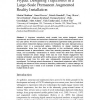Free Online Productivity Tools
i2Speak
i2Symbol
i2OCR
iTex2Img
iWeb2Print
iWeb2Shot
i2Type
iPdf2Split
iPdf2Merge
i2Bopomofo
i2Arabic
i2Style
i2Image
i2PDF
iLatex2Rtf
Sci2ools
ECSCW
2011
2011
Flypad: Designing Trajectories in a Large-Scale Permanent Augmented Reality Installation
A long-term naturalistic study reveals how artists designed, visitors experienced, and curators and technicians maintained a public interactive artwork over a four year period. The work consisted of a collaborative augmented reality game that ran across eleven networked displays (screens and footpads) that were deployed along a winding ramp in a purpose-built gallery. Reflections on design meetings and documentation show how the artists responded to this architectural setting and addressed issues of personalisation, visitor flow, attracting spectators, linking real and virtual, and accessibility. Observations of visitors reveal that while their interactions broadly followed the artistsʼ design, there was far more flexible engagement than originally anticipated, especially within visiting groups, while interviews with curators and technicians reveal how the work was subsequently maintained and ultimately reconfigured. Our findings extend discussions of ʻinteractional trajectoriesʼ wi...
| Added | 19 Dec 2011 |
| Updated | 19 Dec 2011 |
| Type | Journal |
| Year | 2011 |
| Where | ECSCW |
| Authors | Martin Flintham, Stuart Reeves, Patrick Brundell, A. T. Glover, Steve Benford, Duncan Rowland, Boriana Koleva, Chris Greenhalgh, Matt Adams, Nick Tandavanitj, Ju Row-Farr |
Comments (0)

